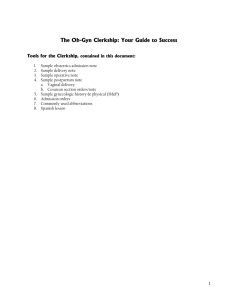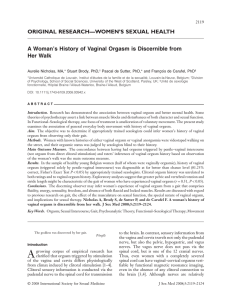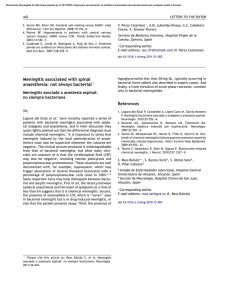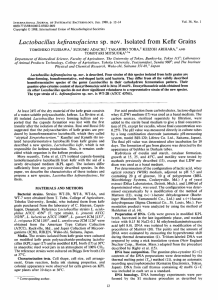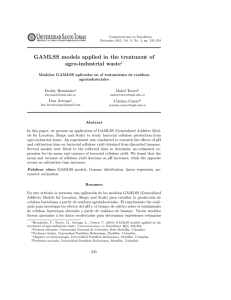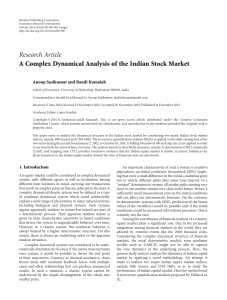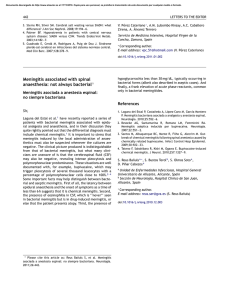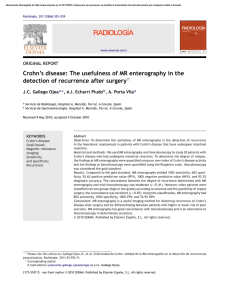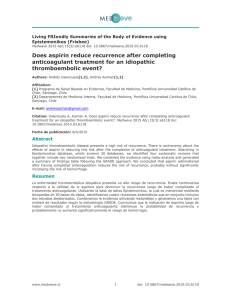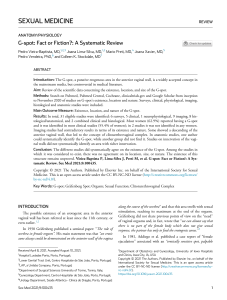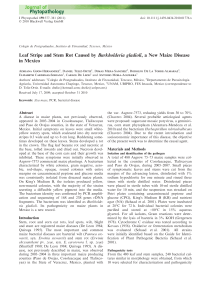Bacterial Vaginosis: Treatment, Recurrence, Disparities
Anuncio
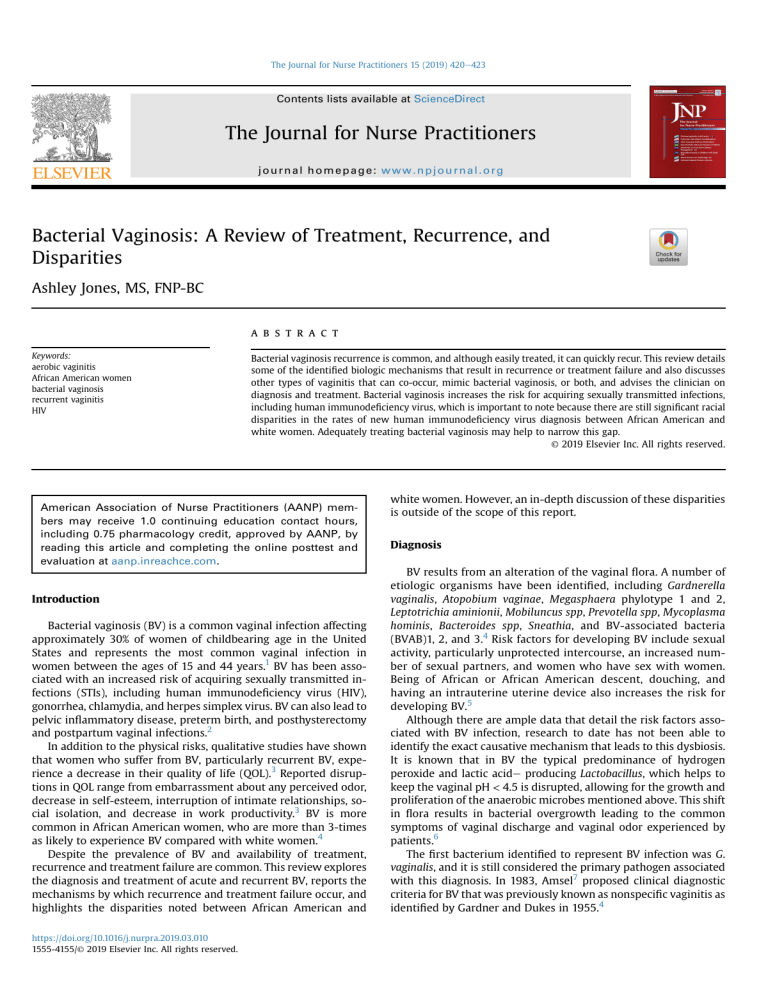
The Journal for Nurse Practitioners 15 (2019) 420e423 Contents lists available at ScienceDirect The Journal for Nurse Practitioners journal homepage: www.npjournal.org Bacterial Vaginosis: A Review of Treatment, Recurrence, and Disparities Ashley Jones, MS, FNP-BC a b s t r a c t Keywords: aerobic vaginitis African American women bacterial vaginosis recurrent vaginitis HIV Bacterial vaginosis recurrence is common, and although easily treated, it can quickly recur. This review details some of the identified biologic mechanisms that result in recurrence or treatment failure and also discusses other types of vaginitis that can co-occur, mimic bacterial vaginosis, or both, and advises the clinician on diagnosis and treatment. Bacterial vaginosis increases the risk for acquiring sexually transmitted infections, including human immunodeficiency virus, which is important to note because there are still significant racial disparities in the rates of new human immunodeficiency virus diagnosis between African American and white women. Adequately treating bacterial vaginosis may help to narrow this gap. © 2019 Elsevier Inc. All rights reserved. American Association of Nurse Practitioners (AANP) members may receive 1.0 continuing education contact hours, including 0.75 pharmacology credit, approved by AANP, by reading this article and completing the online posttest and evaluation at aanp.inreachce.com. Introduction Bacterial vaginosis (BV) is a common vaginal infection affecting approximately 30% of women of childbearing age in the United States and represents the most common vaginal infection in women between the ages of 15 and 44 years.1 BV has been associated with an increased risk of acquiring sexually transmitted infections (STIs), including human immunodeficiency virus (HIV), gonorrhea, chlamydia, and herpes simplex virus. BV can also lead to pelvic inflammatory disease, preterm birth, and posthysterectomy and postpartum vaginal infections.2 In addition to the physical risks, qualitative studies have shown that women who suffer from BV, particularly recurrent BV, experience a decrease in their quality of life (QOL).3 Reported disruptions in QOL range from embarrassment about any perceived odor, decrease in self-esteem, interruption of intimate relationships, social isolation, and decrease in work productivity.3 BV is more common in African American women, who are more than 3-times as likely to experience BV compared with white women.4 Despite the prevalence of BV and availability of treatment, recurrence and treatment failure are common. This review explores the diagnosis and treatment of acute and recurrent BV, reports the mechanisms by which recurrence and treatment failure occur, and highlights the disparities noted between African American and https://doi.org/10.1016/j.nurpra.2019.03.010 1555-4155/© 2019 Elsevier Inc. All rights reserved. white women. However, an in-depth discussion of these disparities is outside of the scope of this report. Diagnosis BV results from an alteration of the vaginal flora. A number of etiologic organisms have been identified, including Gardnerella vaginalis, Atopobium vaginae, Megasphaera phylotype 1 and 2, Leptotrichia aminionii, Mobiluncus spp, Prevotella spp, Mycoplasma hominis, Bacteroides spp, Sneathia, and BV-associated bacteria (BVAB)1, 2, and 3.4 Risk factors for developing BV include sexual activity, particularly unprotected intercourse, an increased number of sexual partners, and women who have sex with women. Being of African or African American descent, douching, and having an intrauterine uterine device also increases the risk for developing BV.5 Although there are ample data that detail the risk factors associated with BV infection, research to date has not been able to identify the exact causative mechanism that leads to this dysbiosis. It is known that in BV the typical predominance of hydrogen peroxide and lactic acide producing Lactobacillus, which helps to keep the vaginal pH < 4.5 is disrupted, allowing for the growth and proliferation of the anaerobic microbes mentioned above. This shift in flora results in bacterial overgrowth leading to the common symptoms of vaginal discharge and vaginal odor experienced by patients.6 The first bacterium identified to represent BV infection was G. vaginalis, and it is still considered the primary pathogen associated with this diagnosis. In 1983, Amsel7 proposed clinical diagnostic criteria for BV that was previously known as nonspecific vaginitis as identified by Gardner and Dukes in 1955.4 A. Jones / The Journal for Nurse Practitioners 15 (2019) 420e423 The diagnosis of BV can be made clinically if the patient meets 3 of the 4 following criteria: (1) presence of a homogenous, thin, grayish-white discharge; (2) vaginal pH 4.5; (3) positive whiff test (amine odor with application of 10% potassium hydroxide to sample); and (4) clue cells (vaginal epithelial cells with a speckled appearance due to being coated with bacteria) on visualization using wet mount microscopy.8 Nugent scoring is also a reliable method of diagnosis commonly used in research studies but is not often seen in clinical practice because it requires Gram staining of the sample. The Nugent score assesses the quantity of the expected Lactobacillus organisms usually present in the vaginal flora in relation to the quantity of other organisms, such as G vaginalis and Mobiluncus spp, that are associated with BV. The sample is scored on a 0 to 10 scale. Scores that fall in the normal range (0-3) indicate there is an adequate presence of Lactobacillus with the absence of G vaginalis and Mobiluncus spp morphotypes. The intermediate range (4-6) represents a decrease in Lactobacillus concentrations but also with the presence of G vaginalis and Mobiluncus spp. Scores in the highest range (7-10) demonstrate the absence of Lactobacillus and the presence of large amounts of G vaginalis and Mobiluncus.4 In clinical settings in which microscopy is not available, detection of G vaginalis DNA using the Affirm VPIII test (Becton, Dickinson and Company, Franklin Lakes, NJ) can be used to help support a diagnosis of BV, particularly in patients with odorous vaginal discharge and an elevated vaginal pH.4 The OSOM BVBlue (Sekisui Diagnostics, LLC, Lexington, MA) can also be used as a point-of-care test for BV diagnosis because results are available within 10 minutes. This test detects the presence of increased sialidase enzyme activity. Sialidase is an enzyme that is frequently produced by BVassociated bacteria that enhances the pathogenicity of organisms by allowing for easier invasion and destruction of tissues. Its presence indicates the existence of a BV-related bacteria.4 Vaginal culture is not useful for diagnosing BV, because many of the microorganisms associated with the condition are not amenable to culture and because colonization of the vagina with various organisms may make culture results difficult to interpret.9 It is important to note that although G vaginalis is the primary bacteria associated with BV, its presence does not always indicate an infection, because this bacterium has also been found in the vaginal flora of healthy individuals without BV and may be present in as many as 55% women who do not have BV.2,4 Treatment and Recurrence The recommended treatments for BV, according to the 2015 Centers for Disease Control and Prevention Sexually Transmitted Disease guidelines, are: (1) oral metronidazole, 500 mg twice daily for 7 days; (2) metronidazole, 0.75% gel intravaginally at bedtime for 5 days; or (3) clindamycin cream, 2% intravaginally at bedtime for 7 days. Alternative regimens include tinidazole, 2 g daily for 2 days; tinidazole, 1 g daily for 5 days; clindamycin, 300 mg twice daily for 7 days; or clindamycin ovules, 100 mg intravaginally at bedtime for 3 days.9 Reported cure rates for an episode of acute BV vary but have been estimated to be between 70% and 80%. Unfortunately, more than 50% of BV cases will recur at least once within the following 12 months.3 Because the etiology of BV is still not entirely understood, identifying the cause of recurrent cases is challenging. Reinfection may play a role in explaining recurrent BV, but treatment failure is a more likely contributor. There are several theories that try to explain recurrence and persistent symptoms. The existence of a biofilm in the vagina is one such theory and is the subject of ongoing research. Biofilms occur when microorganisms adhere to surfaces. G vaginalis, one of the primary organisms 421 associated with BV, is now known to adhere to the vaginal epithelium, which creates a sticky biofilm on the vaginal wall. It is thought that this film may limit penetration of the antibiotics intended to eradicate bacterial growth. The film may also serve as a support scaffolding that allows adherence of other organisms to the biofilm, enhancing colonization of the vagina with various bacterial species.2 Although BV is considered a polymicrobial condition, G vaginalis is the most prominent organism. It is the focus of ongoing microbiological studies because of its unique qualities that can affect virulence and resistance. One of the areas of current interest regarding G vaginalis is which genotypes of G vaginalis produce sialidase and which do not. It is believed that sialidase-producing genotypes are more likely to be associated with biofilm development and subsequently may increase the risk of resistant and recurrent infections.10 In 2016, Schuyler et al published a study that helped broaden our understanding of G vaginalis resistance to metronidazole.11 Four previously identified findings revealed that 2 of the 4 known G vaginalis clades were metronidazole resistant. The 2 remaining clades, which showed less resistance, were more closely related in phylogenetic characteristics. The authors proposed that women with BV may be colonized with multiple G vaginalis clades and that this inherent sensitivity or resistance to metronidazole may impact treatment outcomes and the likelihood of recurrence. It has been recommended that further research in this area be undertaken to translate this finding into the clinical setting and provide clinicians with tests to distinguish between BV clades that are more likely to fail treatment due to innate resistance.11 Treatment of Recurrence The recommended treatment for recurrent BV is metronidazole, 0.75% gel twice weekly for 4 to 6 months, after appropriate treatment of the initial episode of BV with metronidazole or clindamycin. This method has been shown to reduce the rates of BV recurrence by more than 50%.9 Some data support the use of boric acid intravaginally to reacidify the vagina and help create an environment that encourages Lactobacillus and a healthy flora, resulting in a decrease of BV recurrence. With this regimen, metronidazole is prescribed for the usual 7-day course along with vaginal boric acid, 600 mg once daily at bedtime for 21 days. The patient is seen immediately after completion of this regimen and reassessed. If in remission, the patient begins a twice-weekly metronidazole regimen for 4 to 6 months.9 Probiotics have been evaluated as an adjunct treatment of acute BV infection and to deter recurrence. Although individual studies have reported positive outcomes with the use of probiotics, evidence to support the use of probiotics for treatment or prevention of this condition is not yet available.12 There has also been research evaluating the use of presumptive treatment for BV at monthly intervals to reduce BV recurrences, the results of which have demonstrated some success.13 A more novel treatment approach is the use of thermoplastic polyurethane-based intravaginal rings, similar in concept to the NuvaRing (Merck, Kenilworth, NJ) which is being investigated as a potential method of delivering antimicrobials and lactic acid to the vaginal flora for prevention of recurrent BV. There is, however, some discussion that intravaginal rings can be prone to biofilm formation and colonization by bacteria, which would be a potential limitation of this type of treatment, and further studies are needed to evaluate the feasibility of this modality. If mechanical properties related to drug release and delivery can be optimized and there is an adequate method to address the possibility of biofilm formation, intravaginal rings could become a convenient treatment option for BV.14 422 A. Jones / The Journal for Nurse Practitioners 15 (2019) 420e423 Prior research has also demonstrated an association between low serum vitamin D levels and an increased prevalence of BV. Unfortunately, subsequent investigations have not shown a decrease in BV recurrence with high-dose vitamin D supplementation.15 Behavioral Interventions Sexual activity has been identified as a risk factor for BV, but there is not yet sufficient evidence to determine whether it is sexually transmitted. BV-associated bacteria have been found in the male genitalia, although there is no identified male equivalent of BV that results from this colonization.3 Studies have evaluated the benefit of concurrent treatment of male sexual partners of women with BV and have not been able to demonstrate benefit to support partner treatment.3 Prior studies have demonstrated that having multiple sexual partners, having a new sexual partner, having a female sexual partner, and unprotected intercourse are behavioral risk factors for BV.16 Limited data suggest that reducing the number of sexual partners, using condoms during intercourse, and adequate cleaning of shared sexual accessories by women who have sex with women may help to prevent BV recurrence.17 Given that the risk for BV is enhanced by sexual activity, abstinence has been proposed as a method to prevent recurrence because BV is rarely seen in women who have never been sexually active. Avoidance of vaginal hygiene practices, such as douching, have also been recommended to prevent recurrent BV.18 Aerobic Vaginitis Although reinfection, resistance, and treatment failure can make achieving long-term remission of BV challenging, difficulty in achieving adequate remission of BV symptoms could also be due to diagnostic error. A newly identified clinical condition referred to as aerobic vaginitis (AV) was described by Donders et al in 2017 and shares common characteristics with the clinical presentation of BV.19 AV can present with yellow vaginal discharge, labial or vaginal erythema, dyspareunia, and vulvar pain, including burning or stinging. To diagnose AV, wet mount microscopy is performed with evaluation for pH > 4.5, epithelial inflammation, the presence of leukocytes, and absence of lactobacilli. It is plausible that women who were believed to have had treatment failure of BV could have had misdiagnosed AV in some cases.20 Some consider AV to be the aerobic equivalent to BV and may be caused by gastrointestinal flora such as Escherichia coli, Staphylococcus aureus, Streptococcus agalactiae, and Enterococcus faecalis, because they can co-occur with BV and other forms of vaginitis. This distinction is important because it explains treatment failure if this diagnosis was missed and treated solely with metronidazole.19 Severe AV can progress to a condition that is better described in the US literature as desquamative inflammatory vaginitis (DIV). There is a bit of controversy regarding the language and fundamental differences in the conceptualization of this disease progression. In the US, DIV is considered fundamentally an inflammatory response secondarily resulting in dysbiosis rather than a primarily infectious state.21 The signs, symptoms, and microscopic examination findings are similar to those reported in AV. Although opinions differ about the etiology of AV and BV, treatment with clindamycin 2% cream is recommended for both. Given that a component of inflammation is hallmark leading to the diagnosis of AV and BV, consideration of topical corticosteroids may be useful as well, such as compounded hydrocortisone 10% cream. Where their treatment strategies differ is that DIV is considered to be a chronic condition with potential for relapse. As such, treatment for DIV is recommended to continue daily for 4 to 6 weeks, which differs from the recommended 7-day treatment for AV.21 Diagnosis of AV and DIV has been limited in the US due to a need for specialized expertise with microscopy, particularly phase contrast microscopy, to confirm this diagnosis. With an initial estimated prevalence of between 7% and 12%, there is a missed opportunity for adequate treatment of women who are suffering from BV or AV.19 Whether racial and ethnic disparities exist in these situations is not known. Discussion of Racial Disparities Although G vaginalis is the most common and primary organism associated with BV, research has demonstrated that the bacterial composition in the vagina is very diverse. The National Institutes of Health sponsored the Human Microbiome Project (2017), which had the task of determining the genetic sequencing of the microorganisms that are usually present on the skin, mouth, nose, digestive tract, and vagina, in an effort to further characterize what is usually found in healthy populations compared with those with disease.22 There is evidence that the composition of the microbiome (the aggregate of microorganisms that live in and on the human body) can vary by ethnicity. As it relates to this review, such variance has been demonstrated with respect to the vaginal flora. Evaluation of the microbiome of African American women has found that instead of the expected dominance of the protective Lactobacillus spp, G vaginalis, BVAB1, and other anaerobes predominate. When Lactobacillus was present, it was the species that was the least protective against BV. These findings were in direct contrast to white women, who were colonized with various protective Lactobacillus spp, including L crispatus, L jensenii, and L gasseri.23 The fact that African American women are less likely to have protective Lactobacillus strains and more likely to be colonized with L iners (which produces less lactic acid) may account for the higher average pH in the vaginal secretions of African American women and suggest why they are more susceptible to BV.8,23 HIV Disparities Although having BV is distressing enough, the more significant health concerns are the conditions that are more likely to develop as a result of BV. Acquisition of sexually transmitted infections, in particular, HIV, is more likely to occur in women with BV. Atashili et al conducted a meta-analysis of studies in 2008 and found that BV substantially increased the risk of HIV acquisition by 60%. There are several proposed mechanisms by which this may occur. One theory is that the hydrogen peroxide byproduct of Lactobacillus metabolism inactivates the HIV virus. Women with a noted absence of Lactobacillus would not benefit from this protection.24 Another proposed mechanism is that an inflammatory state created by the interaction between certain interleukins and Tolllike receptors causes an increase in the recruitment of target cell populations. There is also evidence suggesting that BV can enhance HIV replication and increase vaginal shedding of HIV.23 Sub-Saharan Africa has high rates of BV and the highest prevalence of HIV in the world. In the US, African American women share a disproportionate burden of HIV/AIDS diagnosis, with infection rates 20-times higher than the rate of white women, and account for nearly two-thirds of all new infections among women.23 This continues to be a significant public health issue, and a better understanding of BV may help to positively impact the HIV/AIDs epidemic, especially as it relates to African American women. A. Jones / The Journal for Nurse Practitioners 15 (2019) 420e423 Conclusion Although BV is the most common vaginal infection in women of childbearing age, it is still not fully understood. Treatment with metronidazole is helpful for some patients. However, recent research has identified various sources for treatment failure and recurrence, including G vaginalis clades with inherent metronidazole resistance, biofilm formation that prevents penetration of antibiotics, and similar but distinct forms of vaginitis that mimic some of the symptoms of BV but require a different treatment. The incidence of AV and DIV are likely underreported, particularly in primary care settings where the use of microscopy has waned over the years in favor of DNA-based methods for the diagnosis of vaginal infections. BV increases the risk of acquiring HIV and other STIs and increases the risk for preterm births. In addition, recurrent BV has been shown to decrease QOL. The burden of this illness has disproportionately affected African American women, and the data have clearly shown that BV is a larger public health issue than just managing an inconvenient vaginitis. It is essential for ongoing research to continue in this area. Core nurse practitioner (NP) competencies include diagnosis and treatment of illness.25 The NP should remain up to date with the various methods for diagnosis and treatment of BV while also maintaining awareness of similar conditions that can mimic or overlap with this condition. Patients trust NPs to be knowledgeable, use high-level diagnostic reasoning, and deliver exceptional patient care. It is imperative to keep up with the ever-evolving clinical landscape. References 1. Centers for Disease Control and Prevention. Bacterial Vaginosis (BV) Statistics. https://www.cdc.gov/std/bv/stats.htm. Accessed February 26, 2019. 2. Machado A, Cerca N. Influence of biofilm formation by Gardnerella vaginalis and other anaerobes on bacterial vaginosis. J Infect Dis. 2015;212:1856-1861. 3. Bradshaw C, Sobel J. Current treatment of bacterial vaginosis. Limitations and need for innovation. J Infect Dis. 2016;214(Suppl 1):S14-S20. 4. Coleman J, Gaydos C. Molecular diagnosis of bacterial vaginosis: an update. J Clin Microbiol. 2018;56(9); e00342-18. 5. Bagnall P. Bacterial vaginosis: a practical review. JAAPA. 2017;30(12):15-21. 6. Amabebe E, Anumba DO. The vaginal microenvironment: the physiologic role of Lactobacilli. Front Med (Lausanne). 2018;5:181. 7. Amsel R, Totten PA, Spiegel CA, Chen KC, Eschenbach D, Holmes KK. Nonspecific vaginitis: diagnostic criteria and microbial and epidemiological associations. Am J Med. 1983;74(1):14-22. 8. Van der Veer C, van Houdt R, van Dam A, de Vries H, Bruisten S. Accuracy of a commercial multiplex PCR for the diagnosis of bacterial vaginosis. J Med Microbiol. 2018;67(9):1265-1270. 9. Workowski KA, Bolan GA. Sexually transmitted diseases treatment guidelines, 2015. MMWR Recomm Rep Morb Mortal Wkly Rep Recomm Rep. 2015;64(RR-03):1. 423 10. Hardy L, Jespers V, Van den Bulck M, et al. The presence of the putative Gardnerella vaginalis sialidase A gene in vaginal specimens is associated with bacterial vaginosis biofilm. PloS One. 2017;12(2):e0172522. https://doi.org/ 10.1371/journal.pone.0172522. 11. Schuyler JA, Mordechai E, Adelson ME, Sobel JD, Gygax SE, Hilbert DW. Identification of intrinsically metronidazole-resistant clades of Gardnerella vaginalis. Diagn Microbiol Infect Dis. 2016;84:1-3. M, Abad C, Safdar N. Probiotics for treatment 12. Hanson L, Vandevusse L, Jerme and prevention of urogenital infections in women: a systematic review. J Midwifery Womens Health. 2016;61(3):339-355. 13. Balkus J, Srinivasan S, Anzala O, et al. Impact of periodic presumptive treatment for bacterial vaginosis on the vaginal microbiome among women participating in the preventing vaginal infections trial. J Infect Dis. 2017;215: 723-731. 14. Verstraete G, Vandenbussche L, Kasmi S, et al. Thermoplastic polyurethanebased intravaginal rings for prophylaxis and treatment of (recurrent) bacterial vaginosis. Int J Pharm. 2017;529:218-226. 15. Turner A, Reese P, Chen P, et al. Serum vitamin D status and bacterial vaginosis prevalence and incidence in Zimbabwean women. Am J Obstet Gynecol. 2016;215(3):332.e1-332.e10. 16. Bautista C, Wurapa E, Sateren W, Morris S, Hollingsworth B, Sanchez J. Bacterial vaginosis: a synthesis of the literature on etiology, prevalence, risk factors, and relationship with chlamydia and gonorrhea infections. Mil Med Res. 2016;3(1):4. 17. Sobel J. Bacterial vaginosis: treatment. UpToDate. https://www.uptodate. com/contents/bacterial-vaginosis-treatment?search¼bacterial%20vaginosis %20treatment&source¼search_result&selectedT itle¼1~81&usage_ type¼default&display_rank¼1. Accessed December 12, 2018. 18. Hodges A, Holland A. Common sexually transmitted infections in women. Nurs Clin North Am. 2018;53(2):189-202. 19. Donders G, Bellen G, Grinceviciene S, Ruban K, Viera-Baptista P. Aerobic vaginitis: no longer a stranger. Res Microbiol. 2017;168(9-10): 845-858. 20. Kaambo E, Africa C, Chambuso R, Passmore J. Vaginal Microbiomes Associated with aerobic vaginitis and bacterial vaginosis. Front Public Health. 2018;6:78. 21. Sobel J. Desquamative inflammatory vaginitis. UptoDate. https://www. uptodate.com/contents/desquamative-inflammatory-vaginitis?search¼ desquamative%20inflammatory%20vaginitis&source¼search_result&se lectedTitle¼1~9&usage_type¼default&display_rank¼1 2017. Accessed August 18, 2018. 22. National Institutes of Health. Human Microbiome Project. 2017. https:// commonfund.nih.gov/hmp. Accessed September 22, 2018. 23. Alcendor D. Evaluation of health disparity in bacterial vaginosis and the implications for HIV-1 acquisition in African American women. Am J Reprod Immunol. 2016;76:99-107. 24. Atashili J, Poole C, Ndumbe PM, Adimora AA, Smith JS. Bacterial vaginosis and HIV acquisition: a meta-analysis of published studies. AIDS. 2008;22: 1493-1501. 25. The National Organization of Nurse Practitioner Faculties (NONPF). 2017 Nurse Practitioner Core Competencies with Curriculum Content. https://www.nonpf. org/resource/resmgr/competencies/2017_NPCoreComps_with_Curric.pdf 2017. Accessed January 14, 2019. Ashley Jones, MS, FNP-BC, works as a nurse practitioner at The Ohio State University, Wexner Medical Center, OSU Family Practice, Gahanna, Ohio. She is available at [email protected]. In compliance with national ethical guidelines, the author reports no relationships with business or industry that would pose a conflict of interest.
